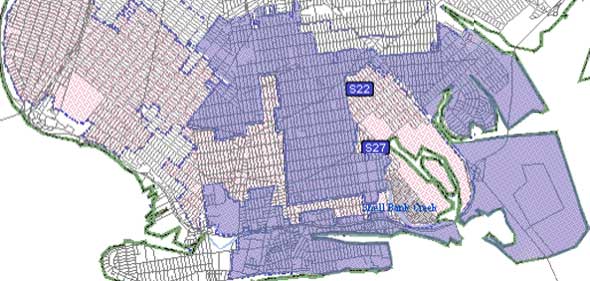State Politicians Get Jiggy With Redistricting Proposal

Looking at political district maps for Brooklyn and the city, you might think you’re gazing at an elaborate jigsaw puzzle. Yet, the process seems to get more complicated, not to mention inequitable, when the lines are redrawn every 10 years.
Nevertheless, the best laid district lines of Democrats or Republicans usually don’t count much towards a representative democracy, but rather for the ruling political party.
Consequently, all state legislative seats are on the ballot this year and the political districts’ pie must be remapped before the elections. Naturally, each party prefers a bigger slice, even after Republicans promised to put an end to gerrymandering, which leaves one party with an advantage over its opponents, and establish an independent redistricting process two years ago when they regained control of the state Senate.
However, as politicians are prone to do, the GOP has broken that promise and is trying to impose politically advantageous boundaries, including a whole new district, either upstate near Albany or in Nassau County, in order to maintain and safeguard its slim majority.
So much for guarantees by politicians, who, more often than not, tend to say whatever they think the voting public wants to hear, then, as soon as they are ensconced in their seat in the legislature, they go their own way knowing incumbents rarely lose in state elections.
The new state senate lines for Brooklyn, revealed on February 2, eliminate the 27th district, which was represented by Carl Kruger for over a decade until he pled guilty to corruption charges and resigned last December. That district includes real estate from Mill Basin, west to Brighton Beach. If it is purged, the GOP will expand the districts currently represented by state senators Mary Golden, a Republican, and John Sampson, a Democrat, who would add Mill Basin and Bergen Beach to communities, including Canarsie, he already represents.
In response to the proposed controversial boundaries drawn up by a legislative force, which prompted a lawsuit, Brooklyn Federal District Court Judge Dora Irizarry recommended that the state’s stalled redistricting process be supervised by a court-appointed special master to ensure it complies with state and federal laws.
Two weeks ago, another lawsuit was filed by Senate Democrats challenging the GOP plan, which has drawn criticism from advocates who oppose district changes they maintain are unfair to minorities. Republicans insist that the convoluted formula is valid according to New York’s Constitution.
The proposed remapping would also make pointless the special March 20 election for Kruger’s spot between Democratic candidate City Councilman Lew Fidler and Republican opponent David Storobin.
Political insiders insist there’s a slim chance the proposed lines will be adopted, since Governor Andrew Cuomo vowed to veto any partisan remapping after his request for an independent redistricting commission was declined. Let’s hope the governor doesn’t agree to any compromise that would lead him renege, like the Republicans did.
Independent activists called the GOP plan “the most gerrymandered lines” in recent history. Former Mayor Ed Koch, who has advocated independent redistricting, said he was disappointed in the proposal and a victory “lies with the enemies of reform.”
Therefore, the only way to alter and impartially balance subsequent redistricting is to change the Constitution and let the citizens of New York vote on it. Although that creates another challenge: making voters understand what’s really at stake and getting a sufficient, concerned number of them to participate in the process.
However, some registered voters are so apathetic to politics they have no clue as to who represents them on the local, state and federal levels. So it comes as no surprise that few even know — or care — about district boundaries, whether it’s for the City Council, the state Assembly or Senate or the U.S. Congress.
Come to think of it, it’s easier to solve the weekly Sheepshead Bites picture puzzle than it is to make sense out of jagged, legislated political districts.
As our state politicians pat themselves on the back for instituting some meaningful recent reforms, they should be embarrassed about neglecting practical district lines that only give the ruling party an advantage, not the people who elected them.
More importantly, voters need to wake up, smell the scam and send a clear-cut message when they go to the polls in November: “We’re mad as hell and we’re not going to take you gerrymandering anymore!”
Neil S. Friedman is a veteran reporter and photographer, and spent 15 years as an editor for a Brooklyn weekly newspaper. He also did public relations work for Showtime, The Rolling Stones and Michael Jackson. Friedman contributes occasional columns on life, culture and politics in Sheepshead Bay
.



